Eid Al-Fitr – Islamic Prayer in Art
The distinctive ritual of Islamic prayer, known as namaz (in Urdu) or salah (in Arabic) has captivated the imagination of many Orientalist painters.
Maya M. Tola 10 April 2024
Edward Hopper (1892–1967) was one of the greatest painters to ever come out of the United States. A leading painter of American Realism and modern art, Hopper was known for his contemplative style, presenting uniquely American scenes from the early to mid-20th century.
Edward Hopper’s paintings primarily feature urban landscapes and scenes of ordinary people in everyday life. His subjects, often female figures modeled after his wife and fellow artist Josephine Hopper, are typically depicted in repose or solitude. The interplay of light, shadow, and angles in his works underscores themes of isolation and introspection. Hopper’s signature style is unmistakable, making the experience of viewing his work truly unique.
The ambiguity in his paintings adds a layer of wonder and contemplation, enhancing the emotional responses they evoke. Selecting just ten of Edward Hopper’s many masterpieces is a challenging task, but here’s my attempt to highlight some of his most compelling works.
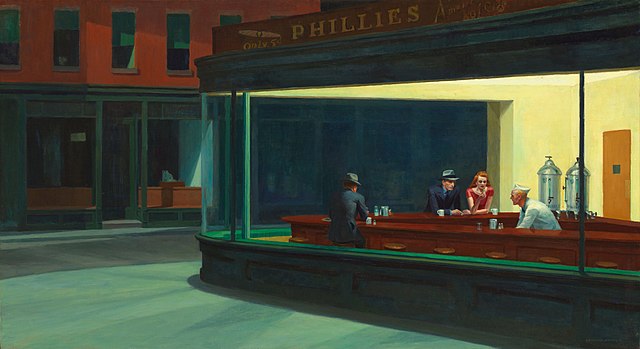
Edward Hopper, Nighthawks, 1942, Art Institute of Chicago, Chicago, IL, USA.
Nighthawks is Hopper’s most famous painting. You’ve probably seen it even if you didn’t know anything about it or the artist behind it. Hopper’s masterpiece is ubiquitous in American culture—it’s become a meme, been parodied, analyzed in schools, and displayed on merchandise. Despite this, it still captivates and mesmerizes. Like most of Hopper’s work, it poses more questions than answers.
The late-night diner is closed in, almost like a clear glass tube with its curving corner. Except there’s no entrance to the place nor an exit. There are four figures: a man sitting alone, a couple just across the bar, and a server on the other side of the counter. There’s not much inside the diner or on the external street. Despite the intriguing, ostensibly unsettling scene, the lighting is calm, and the composition is comforting. Every intentional interaction brings something new to gain from or to think about.
It’s a must-see at the Art Institute of Chicago and a wonderful, legendary piece of American art.
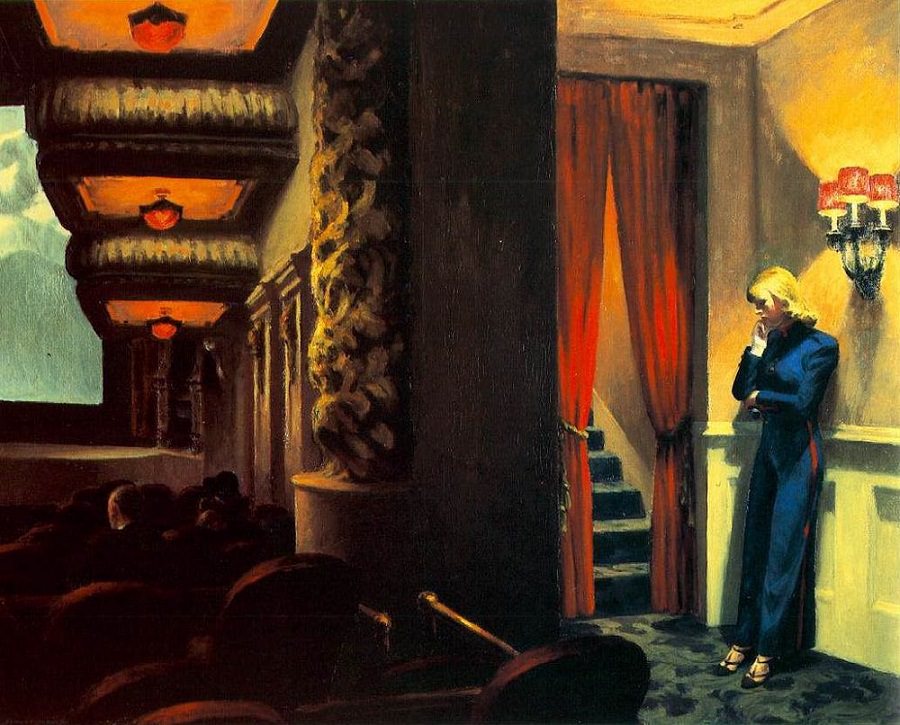
Edward Hopper, New York Movie, 1939, Museum of Modern Art, New York City, NY, USA.
This is my personal favorite of Hopper’s work. It’s one of his most melancholy paintings and another striking composition of dramatic light and shadow. Like most of his female models, the woman is based on Hopper’s wife and artist, Josephine. Based on her clothing, the woman appears to be an usher at the theater, a bygone occupation today. She leans against the wall in repose, her hand on her chin, either thinking or watching the screen to the left, an unrecognizable film.
No matter what she’s doing, it’s clear she’s in a sacred place. Theatergoers can also be seen sitting in the seats on the left. It’s a lovely piece that can be felt more acutely today if you dwell in the nostalgia it imbues for the era of classic, communal moviegoing. Hopper loved motion pictures, and New York Movie was his masterful way of showing that love.

Edward Hopper, Automat, 1927, Des Moines Art Center, Des Moines, IA, USA.
Hopper’s Automat represents a location from a bygone era and another lonely female subject. Automats, the self-serving cafeterias of 20th-century America, are no longer around. There is a lot to glean from this piece, and all of it is questions rather than answers.
There’s not much to the interior of the scene except the well-dressed woman sitting at the marble-top table with one glove on. Who is she? Where is she going, or where has she been? Why is she all alone at this automat? The light fixtures reflected in the dark window seem to go on endlessly. It’s a beautiful, thought-provoking piece.
Light, shadow, and angles work to emphasize solitude and introspection.
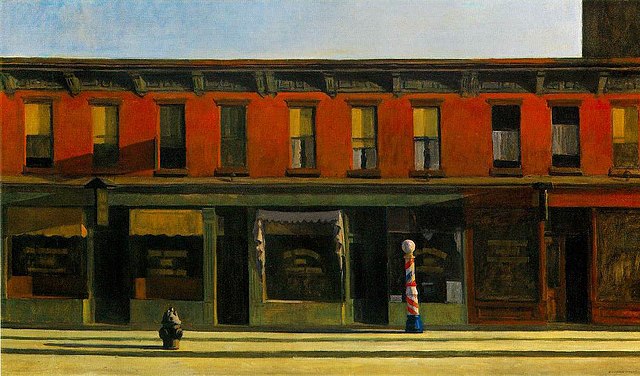
Edward Hopper, Early Sunday Morning, 1930, Whitney Museum of American Art, New York City, NY, USA.
Early Sunday Morning incidentally resonated with New Yorkers during the pandemic in 2020–2021. Hopper’s painting, though from 1930, is an ominous representation of the streets of New York City during lockdown. However, Hopper seemed to be conveying something much different. The storefront window signs on the small stores are unintelligible, and the barber pole is the only indication of any specific store or business.
There’s no sign of life on the streets or in the white curtains of the windows. It seems to be a composition of ordinary America without the American people. And being 1930, it could represent the city just after the Stock Market Crash of 1929. I don’t believe, as with any painting, there’s a wrong reaction to this one. It can make you feel uneasy or serene—that is the best part of Early Sunday Morning. Even better, further visits to the piece can imbue a different feeling.
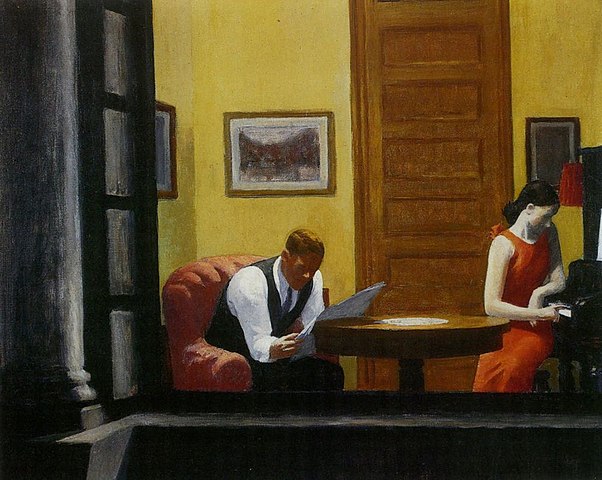
Edward Hopper, Room in New York, 1932, Sheldon Museum of Art, Lincoln, NE, USA
The voyeuristic feel of Room in New York comes from Hopper’s tendency to glimpse apartment windows around his home in Washington Square. He decided on the angle, light, and subject of the scene through sketches. What resulted was another ambiguous work involving a couple in an apartment. It contains the “blind field” that Hopper frequently included in his paintings.
The man to the left leans forward, reading a newspaper, while the woman sits just a few feet away to the right, her finger on a piano key. The cropped view, almost like a camera zooming in, gives us a narrow look at the couple. What is going on between them, if anything? At first glance, there seems to be some tension between them. But after further inspection, maybe not. Hopper inspires us to look closer.

Edward Hopper, Morning Sun, 1952, Columbus Museum of Art, Columbus, OH, USA.
This painting by Hopper epitomizes his focus on solitude and introspection. The woman, modeled after Josephine Hopper, sits on her bed with bare arms and legs, looking out the window toward the sunlight, perhaps the sunrise, and appears to be thinking deeply. The building through the window shows that she’s high up in her apartment, secluded in an urban environment.
Her right eye is a noticeable black spot, the “blind field” of the painting being only what she perceives in this scene. The light is bright on the empty wall and casting shadows. It’s a private moment we could have related to during the pandemic in 2020. Jo Hopper was 69 years old when her husband painted Morning Sun, yet he portrayed her as a youthful figure in the painting.
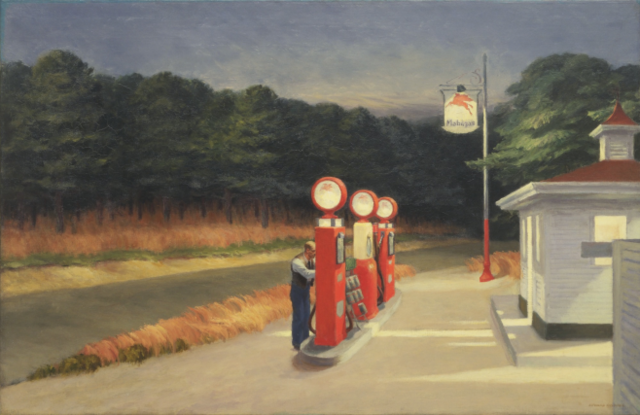
Edward Hopper, Gas, 1940, Museum of Modern Art, New York City, NY, USA.
Like many of Hopper’s rural paintings, Gas is a stark rendering of middle America. This is Hopper’s version of being on the road. The green trees to the left and red gas pumps in the center contrast quite harshly with the white, brightly lit station to the right. The road disappears into the dark woods while the attendant—though there’s no parked car—tends to the pump. Hopper’s attention to detail is found on the sign that reads “Mobilgas.”
Though it’s a realistic portrayal of rural America during this time, it still contains the edgier elements of Hopper’s work. It’s what one would expect from Hopper when depicting a transitional space. Mysterious, ominous, and slight.
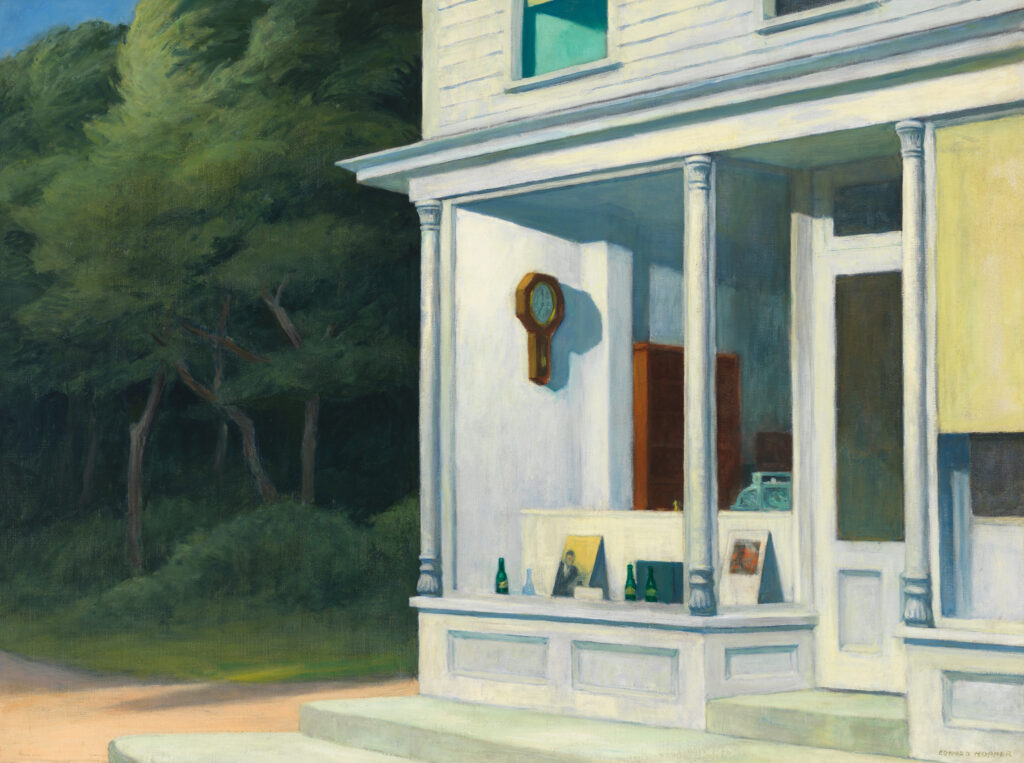
Edward Hopper, Seven A.M., 1948, Whitney Museum of American Art, New York City, NY, USA.
When walking the New York City streets during the pandemic, I always thought of this painting. Closed storefronts still displayed items through their windows while the business inside was dark and empty. This particular storefront is believed to be based on one the artist saw in Upper Nyack, a village north of New York City where Hopper grew up. Again, the sun shines brightly on the store and through the windows until it recedes into the covered darkness.
The clock reads 7 A.M., hence the title. Perhaps the owner likes to sleep in and opens their shop much later. It’s a serene piece with no human subject, a presentation of a simple corner store with plenty to interpret.
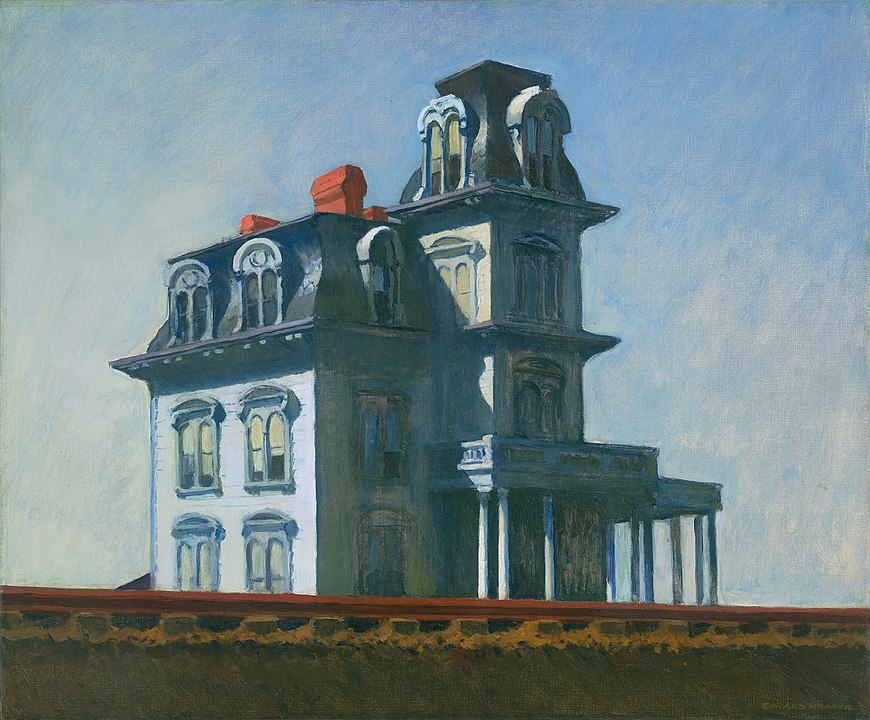
Edward Hopper, House by the Railroad, 1925, Museum of Modern Art, New York City, NY, USA.
House by the Railroad has two interesting facts that distinguish it from the rest of the artist’s work. It was the first painting of Hopper’s to be acquired by the Museum of Modern Art in New York City. Also, the house in the painting inspired the legendary filmmaker Alfred Hitchcock to model the Bates residence in Pyscho after it. Hopper, a lover of cinema himself, was amused by this. Unsurprisingly, Hopper’s work also influenced Hitchcock’s 1954 film Rear Window.
Hopper found this beautiful Victorian mansion outside of Nyack and depicted its striking mansard roof reaching high above the railroad below. Human subjects weren’t the only figures to sit alone in a Hopper painting. Majestic buildings such as this could conjure just as much introspection in a solitary space.
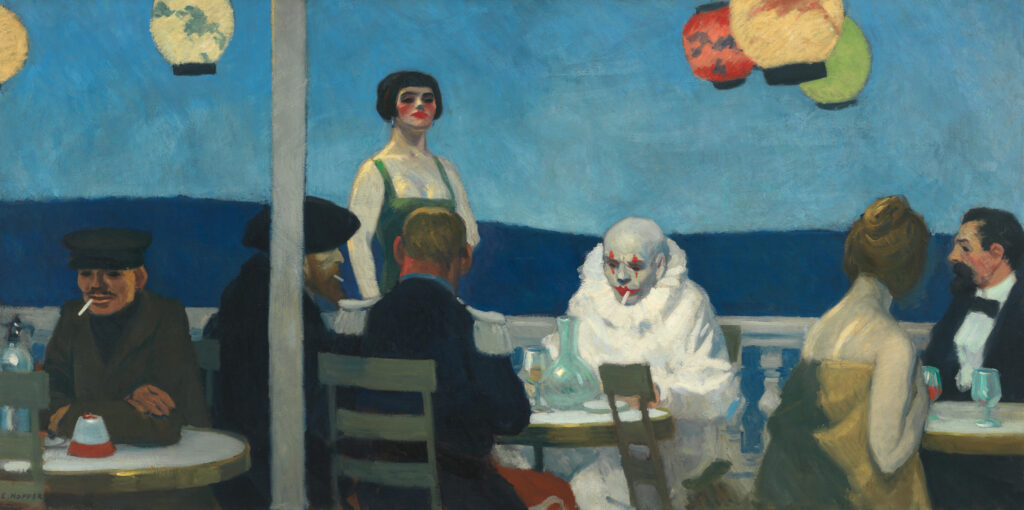
Edward Hopper, Soir Bleu, 1914, Whitney Museum of American Art, New York City, NY, USA.
This is an early painting by Edward Hopper. First, it does not depict any American subjects or locations. It is set in a cafe in France. However, it is still a striking example of urban detachment. While it’s unclear what irony the sad clown represents, his presence sitting among the other patrons is quite moving.
Speaking of the other patrons, they also look dejected in their manners of sitting, smoking, or gazing. The woman standing near the clown has a face full of make-up, perhaps a prostitute unhappy with her situation. It’s another sorrow-ridden piece by Hopper, but one that leaves quite an impression. Of the paintings from his early work, Soir Bleu has endured the most.
DailyArt Magazine needs your support. Every contribution, however big or small, is very valuable for our future. Thanks to it, we will be able to sustain and grow the Magazine. Thank you for your help!